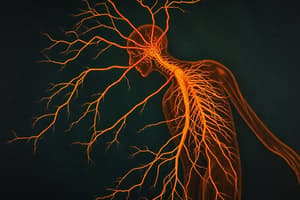Podcast
Questions and Answers
What are the two main communication systems orchestrating the human body?
What are the two main communication systems orchestrating the human body?
The nervous system and the endocrine system
What are the two major parts of the nervous system?
What are the two major parts of the nervous system?
Central Nervous System (CNS) and Peripheral Nervous System (PNS)
Which part of the nervous system serves as the body's control centers?
Which part of the nervous system serves as the body's control centers?
Central Nervous System (CNS)
What is the responsibility of the Somatic Nervous System?
What is the responsibility of the Somatic Nervous System?
What are the two branches of the Autonomic Nervous System?
What are the two branches of the Autonomic Nervous System?
What is the role of sensory neurons in the nervous system?
What is the role of sensory neurons in the nervous system?
How do reflexes differ from voluntary movements in terms of nervous system control?
How do reflexes differ from voluntary movements in terms of nervous system control?
What is the function of neurotransmitters in neuronal communication?
What is the function of neurotransmitters in neuronal communication?
Explain the concept of synaptic plasticity and its significance in the nervous system.
Explain the concept of synaptic plasticity and its significance in the nervous system.
How are artificial neural networks related to biological neural networks?
How are artificial neural networks related to biological neural networks?
Study Notes
The Nervous System and Control: The Power of Communication
The human body is intricately orchestrated by two main communication systems: the nervous system and the endocrine system. In this article, we will delve into the complexities of the nervous system, which plays a crucial role in control and coordination.
The Nervous System: Structure and Function
The nervous system is a vast network of specialized cells designed to transmit information between the body and the brain. It consists of two major parts: the central nervous system (CNS) and the peripheral nervous system (PNS).
-
Central Nervous System (CNS): This includes the brain and the spinal cord, which serve as the body's control centers. The CNS processes information, interprets sensory input, and sends out motor commands to control movement, emotion, and cognition.
-
Peripheral Nervous System (PNS): This system consists of nerves that extend from the CNS to the rest of the body, transmitting commands and sensory information. The PNS can be further divided into two subsystems:
- Somatic Nervous System: This system is responsible for voluntary actions, such as muscle movement and sensory inputs like touch and temperature.
- Autonomic Nervous System: This system is responsible for involuntary actions, such as heart rate, digestion, and temperature regulation. The autonomic nervous system can be further divided into two branches: the sympathetic and parasympathetic systems.
Control and Coordination: The Nervous System in Action
The nervous system constantly communicates with the body to ensure that every organ and cell receives the appropriate input and sends the appropriate response. These functions are achieved through several key processes:
-
Sensory input: The nervous system collects information from the body through specialized cells called sensory neurons, which transmit this data to the CNS. This data is then processed and interpreted to form a response.
-
Motor output: Based on the information received from sensory input, the nervous system generates motor commands that control muscle activity to execute voluntary movements.
-
Reflexes: Reflexes are involuntary responses to sensory input, often occurring in the PNS without the need for input from the CNS. For example, withdrawing a hand from a hot stove occurs as a reflex action, without requiring conscious thought.
-
Neurotransmission: Nerve cells communicate with each other through chemical messengers called neurotransmitters, which are released into the spaces between cells called synapses. These neurotransmitters either facilitate or inhibit communication between neurons, allowing for complex information processing.
-
Neuronal communication: Communication between neurons occurs through the formation of connections called synapses, which can be strengthened or weakened depending on the pattern of stimulation the neurons receive. This process of synaptic plasticity allows the nervous system to adapt and learn from new experiences.
The Nervous System in Modern Applications
The functions of the nervous system are not limited to the body's internal regulation. Modern technology has also harnessed the power of neural communication for innovative applications.
-
Artificial neural networks: These computer systems are inspired by the structure and function of biological neural networks, and they have revolutionized fields like machine learning and artificial intelligence.
-
Neuromorphic computing: This emerging technology seeks to mimic the structure and function of the nervous system to create more energy-efficient and adaptive computing systems.
-
Bing Chat "No-Search" feature: Microsoft's Bing Chat has introduced a feature that allows users to disable its connection to the web, enabling the chatbot to solve complex problems or engage in casual conversations without the need for internet searches.
In conclusion, the nervous system is a complex communication network that allows the body to control and coordinate its activities, ensuring a seamless exchange of information between the brain and the rest of the body. By understanding the nervous system and its various functions, we can better appreciate the intricate dance of control and coordination that makes up the human experience.
Studying That Suits You
Use AI to generate personalized quizzes and flashcards to suit your learning preferences.
Description
Discover the intricacies of the nervous system and its vital role in control, coordination, sensory input, motor output, neurotransmission, and modern applications like artificial neural networks and neuromorphic computing.





